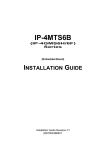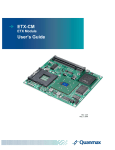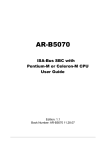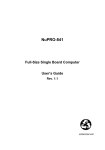Download EBC5852-C8 User`s Manual
Transcript
EBC5852-C8 User’s Manual Revision 1.2 © COPYRIGHT All rights reserved. The information contained in this guide has been validated and reviewed for accuracy. No patent liability is assumed with respect to the use of the information contained herein. While every precaution has been taken in the preparation of this guide, the Manufacturer assumes no responsibility for errors or omissions. No part of this publication may be reproduced, stored in a retrieval system, or transmitted in any form or by any means, electronic, mechanical, photocopying, recording, or otherwise, without the prior written permission of Manufacturer. TRADEMARK™ ® ® ® ® Intel , Pentium and Celeron are registered trademarks of Intel Corporation. ® ® Microsoft and Windows are registered trademarks of Microsoft Corporation. All products and company names are trademarks or registered trademarks of their respective holders. These specifications are subject to change without notice. ii CONTENTS SECTION 1 INTRODUCTION 1.1 Unpacking EBC5852-C8 1.2 Description 1.3 Features 1.3.1 Graphic & Ethernet 1.3.2 Ultra ATA/66/100 1.3.3 SATA150 1.3.4 Hardware Monitoring 1.3.5 I/O Shield Connector 1.3.6 EBC5852-C8 Overview 1.3.7 System Block Diagram 1.4 Specifications 1.5 Mechanical Dimensions 1 1 3 3 3 4 4 4 4 5 6 7 9 SECTION 2 INSTALLATIONS 2.1 System Installation 2.1.1 CPU Installation 2.1.2 Heat Sink Installation 2.1.3 Memory Module Installation 2.1.4 Setting Jumpers 2.2 Board Layout 2.3 Jumper Setting 2.4 Connector’s Description 10 10 10 11 11 11 12 13 15 SECTION 3 AWARD BIOS SETUP 3.1 BIOS Instructions 3.2 Main Menu 3.3 Standard CMOS Features 3.4 IDE Adapters 3.5 Advanced BIOS Features 3.6 Advanced Chipset Features 3.7 Integrated Peripherals 3.8 Power Management Setup 3.9 PnP/PCI Configurations 3.10 PC Health Status 3.11 Frequency/Voltage Control 3.12 Load Fail-Safe Default 3.13 Load Optimized Defaults 3.14 Supervisor/User Password Setting 3.15 Exit Selecting 28 28 29 31 33 35 38 41 44 47 49 50 50 50 51 51 iii SECTION 1 INTRODUCTION 1.1 Unpacking EBC5852-C8 1. Take out the EBC5852-C8 unit from the carton box, check if the unit is properly secure in the plastic bag. 2. Check the contents of the carton box: Embedded board Heat sink Driver CD Installation guide 1 Introduction ATA-66/100 HDD ribbon cable K/B & M/S Y type cable 3. Optional Kits USB cable (1 Set) (for USB2.0) Line_out cable (1 Set) 2 Introduction 1.2 Description ® The EBC5852-C8 combines the high performance and exceptional value of the Intel 852GM chipset ® ® with a full-featured board. This Intel 852GM chipset supports a Celeron M 800MHz processor running at an FSB of 400 MHz. The DDR SDRAM interface supports up to 1GB of RAM, and has an integrated LVDS ® ® & VGA function. It features one onboard Intel 82562GT (10/100) and a Realtek 8110S (10/100/1000) ® Ethernet controller, Realtek ALC655 audio, two SATA connectors (1.5 Gbps), one IDE channel interface (ATA 33/66/100), one CF socket (through IDE bus), two COM ports, and six USB2.0 ports (two on the rear panel and four internal). The EBC5852-C8 is highly suitable for POS PC, Panel PC, KIOSK and thin client applications. ® The 82801DB I/O Controller Hub (ICH4) employs the Intel Accelerated Hub Architecture to make a direct connection from the graphics and memory to the I/O devices to meet performance, stability and reliability requirements. 1.3 Features 1.3.1 Graphic & Ethernet ® The EBC5852-C8 is based on the Intel 852GM chipset, which offers integrated LVDS, Graphic, and Ethernet functions. The features of system are as below: Enhanced integrated LVDS & graphics: - 400 MHz FSB support - 18 bit dual channels LVDS, resolution up to 1600 x 1200 UXGA - Onboard LVDS interface & VGA connectors Build-in Ethernet: ® - 1x onboard Intel 82562GT Ethernet controller (10/100) ® - 1x Realtek 8110S Gigabit Ethernet controller (10/100/1000) Memory: - DDR SDRAM 200/266 - 1x 200-pins SO-DIMM socket - 1.0GB Max. IO Connectivity - ICH4: - 6 Hi-Speed USB2.0 ports ® - Realtek ALC655 Audio Codec 3 Introduction 1.3.2 Ultra ATA/66/100 The ICH4 provides two channel Ultra ATA/66/100 Bus Master IDE controller, that support Ultra ATA/66/100 protocols, perfect for demanding applications such as real-time video, multimedia, and high performance operating system. A special 80-conductor IDE cable is required for Ultra ATA/66/100 functionality. This cable is, of course, backwards compatible with ATA/33. 1.3.3 SATA150 The SiI3512E is a single-chip PCI to 2-port Serial ATA host controller. It provides two Serial ATA channels with 1.5 Gbps (150 MB/s) bandwidth. The SiI3512E is compliant with Serial ATA 1.0 specification, and supports ATAPI devices such as CD-ROM, CD-RW, DVD-ROM, DVD+R, etc. 1.3.4 Hardware Monitoring Hardware monitoring allows you to monitor various aspects of your systems operations and status. The features include CPU temperature, voltage and RPM of fan. 1.3.5 I/O Shield Connector The board is equipped with an I/O panel. Please use the appropriate I/O shield (figure 1). Figure 1: I/O back panel layout 4 Introduction 1.3.6 EBC5852-C8 Overview Function / Model Processor Chipset LVDS function EBC5852-C8 Onboard Intel® 852GM 1 VGA function 1 Ethernet function 1 Audio function 1 40-pins EIDE interface 1 SATA interface 2 PCI slot 1 Serial ports 2 USB 2.0 ports (four for optional USB cable) 6 Type II CF socket (optional) 1 LAN extend to front panel LED pin-header 2 Audio line-out pin-header 1 5 Installations 1.3.7 System Block Diagram Figure 2: System Block Diagram 6 Introduction 1.4 Specifications Processor: ® - Onboard 800MHz Celeron M with 0-L2 cache processor - System bus frequency at 400 MHz FSB Chipset: ® - Intel 852GM + ICH4 DRAM Module: - 1 x 200-pins SO-DIMM socket, for DDR 200/266 Memory - Support DDR SDRAM up to 1GB (Max.) LVDS & VGA Function: ® - Intel 852GM chipset integrated LVDS & Graphic controller - Support 18-bit dual channels LVDS panel - Resolution up to 1600 x 1200 UXGA - Onboard one VGA connector Ethernet Function: ® - Intel 82562GT Ethernet controller, for 10/100 Base-TX Ethernet ® - Realtek 8110S Gigabit Ethernet controller, for 10/100/1000 Base-TX Ethernet Expansion Slot: - 1 x PCI Riser slot Onboard I/O: - On-Chip I/O integrated with K/B, Mouse and Serial controller Onboard PCI / IDE: ® - Intel 82801DB (ICH4) Controller - ACPI Compliant Power Management - Two SATA150 connectors - One 40-pin 2.54 pitch connector for PIO/Ultra DMA-100 (Up to 2 devices) - One CF socket through Secondary IDE channel Rear I/O Connectors: - 1 x DC-IN power jack - 1 x D-Sub 9-pins COM1 serial port connector for RS-232 - 2 x RJ-45 Ethernet connector - PS/2 type connector for keyboard or mouse - 1 x VGA connector - Audio for Line-Out, MIC phone jack - 2 x USB2.0 (USB 0/1) connectors Internal I/O Connectors (pin-header): - 1 x COM port connectors (all COM ports for RS-232) - 4 x USB2.0 connectors (USB cable with bracket by optional) - 2 x LAN LED pin-header (for front panel indication) 7 Introduction Power Connector: - 4-pins output power connector, support +5V, +12V - 1 x DC-IN power jack for DC14V ~ 21V power adapter BIOS: - Award Plug & Play BIOS Form Factor: - 5.75” x 8.0” (146 x 203mm), 5 1/4” Size Weight: - 0.77lb (350g) --- EBC5852-C8 8 Introduction 1.5 Mechanical Dimensions 9 Introduction SECTION 2 INSTALLATIONS 2.1 System Installation 2.1.1 Memory Module Installation Figure 3 display the notch marks and what they should look like on your SO-DIMM memory module. SO-DIMM has 200-pins and two notches that will match with the onboard SO-DIMM socket. Memory modules are installed by placing the chip firmly into the socket at a parallel angle and pressing straight down (figure 4) until it fits tightly into the SO-DIMM socket. Figure 3: SO-DIMM Memory and 200-pins Socket Figure 4: Memory Installation Carefully follow the steps below in order to install the memory: 1. To avoid generating static electricity and damaging the memory, ground yourself by touching a grounded metal surface or using a ground scrap before you touch the memory. 2. Do not touch the connector of the SO-DIMM. Dirt residue may cause a malfunction. 3. Hold the memory with its notch to the front side of the EBC5852-C8 and insert it completely into the socket. A memory should be inserted into the inner socket first. Guiding the hole at each end of the SO-DIMM over the retaining post at each end of the memory socket. 4. If memory does not go in smoothly, do not force it. Pull it all the way out and try again. 5. Make sure the memory is properly installed and locked by the tabs on both sides of the socket. 10 Introduction Removing a Memory: To remove the memory, use your fingers or a small screwdriver to carefully push away the plastic tabs that secure the memory at each end. Lift it out of the socket. Make sure you store the memory in an anti-static bag. 2.1.2 Setting Jumpers There are jumpers on the embedded board of the EBC5852-C8. You can set the jumpers to make the necessary operations. Figure 5: Jumper Connector For any three-pin jumpers (Figure 5), the jumper setting is 1-2 when the jumper connects pins 1 and 2. The setting is 2-3 when pins 2 and 3 are connected and so on. You see one of the lines surrounding jumpers is thick, which indicates pin NO.1. To move a jumper from one position to another, use needle-nose pliers or tweezers to pull the pin cap off the pins and move it to the desired position. 11 Installations 2.2 Board Layout Jumper & Connector Location 12 Installations 2.3 Jumper Setting Table for Jumper Location Description: Use the information in the following table to change the jumpers. Jumpers JP2 JP3 JP4 JP5 JP6 JP7 Functions BIOS write protection setting select LVDS voltage setting select Watchdog timer setting select Chassis Intrusion detection Clear CMOS setting select Auto power on setting select In order to set up the correct configuration, here is the description about how to set the jumpers to enable/disable or change functions. All jumpers’ location please refers to jumper location diagram. BIOS write protection setting select: JP2 Function BIOS write protection Location: JP2 On Off Normal (Default) LVDS voltage setting select: JP3 Location: Function JP3 3.3V (Default) 5V 1-2 2-3 13 Installations Watchdog timer setting select: JP4 Location: Function JP4 NMI Reset System (Default) 1-2 2-3 Chassis Intrusion detection: JP5 Function JP5 Trigger chassis intrusion Normal (Default) On Off Location: Clear CMOS setting select: JP6 Location: Function JP6 Normal (Default) Clear CMOS 1-2 2-3 Auto power on setting select: JP7 Function JP7 Auto power on Normal (Default) On Off Location: 14 Introduction 2.4 Connector’s Description Connector Location 15 Installations Table for Connector’s Location Description: Use the information in the following table to change the connector. Connectors CN1 CN2 CN3 CN4 CN5 CN6 CN7 CN8 CN9 CN10 CN11 CN12 CN13 CN14 CN15 CN16 CN17 CN18 CN20 CN21 CN22 CN24 CN25 Functions CRT VGA port connector COM1 RS-232 serial port connector Audio MIC_In phone jack Audio Line_Out phone jack PS/2 keyboard or mouse connector Ethernet RJ-45 connector USB 0/1 connectors Ethernet RJ-45 connector DC-In power jack Audio Line_Out pin-header USB 2/3 pin-header USB 4/5 pin-header CD-In pin-header LAN1 LED pin-header Inverter connector LAN2 LED pin-header LVDS panel interface Primary IDE connector COM2 serial port connector CPU fan power connector SMBUS connector 4-pins 12V/5V output power connector System panel indicate pin-header 16 Installations CRT VGA port connector (D-SUB 15-pins female): CN1 Pin # Assignment Pin # Assignment 1 3 5 7 9 11 13 15 Red Blue Ground Ground VCC NC Hsync DDClk 2 4 6 8 10 12 14 Green NC Ground Ground Ground DDData VSync Figure: 5 1 15 11 COM1 RS-232 serial port connector (D-Sub 9-pins male): CN2 Pin # Assignment Pin # Assignment 1 2 3 4 5 DCD (Data Carrier Detect) RXD (Receive Data) TXD (Transmit Data) DTR (Data Terminal Ready) Ground 6 7 8 9 DSR (Data Set Ready) RTS (Request to Send) CTS (Clear to Send) RI (Ring Indicator) Figure: 1 5 6 9 17 Installations Audio MIC_In phone jack: CN3 Figure: Pin # Assignment Red MIC-In Audio Line_Out phone jack: CN4 Figure: Pin # Assignment Green Line-Out PS/2 keyboard or mouse connector (6-pins Mini Din): CN5 Pin # Assignment Pin # Assignment 1 3 5 Keyboard data Ground Keyboard clock 2 4 6 Mouse data VCC Mouse clock Figure: 6 5 4 3 2 1 18 Installations LAN1 RJ-45 connector (RJ-45 phone jack): CN6 Pin # Assignment Pin # Assignment 1 2 3 4 Transmit output (+) Transmit output (-) Receive input (+) NC 5 6 7 8 NC Receive input (-) NC NC Figure: 8 1 USB 0/1 connector: CN7 Pin # Assignment Pin # Assignment 1a 2a 3a 4a VCC USB0 USB0 + Signal ground 1b 2b 3b 4b VCC USB1 USB1 + Signal ground Figure: 1 4 1 4 LAN2 RJ-45 connector (RJ-45 phone jack): CN8 Pin # Assignment Pin # Assignment 1 2 3 4 Transmit output (+) Transmit output (-) Receive input (+) NC 5 6 7 8 NC Receive input (-) NC NC Figure: 4 6 19 Introduction DC-In power jack: CN9 Figure: Pin # Assignment 1 VCC Audio Line_Out pin-header (4-pins wafer): CN10 Figure: Pin # Assignment 1 2 3 4 LOUT_L AU_GND VCC LOUT_R 1 4 USB 2/3 pin-header (10-pins): CN11 Pin # Assignment Pin # Assignment 1 3 5 7 9 VCC USB2 USB2 + Ground --- 2 4 6 8 10 VCC USB3 USB3 + Ground NC Figure: 10 9 2 1 20 Installations USB 4/5 pin-header (10-pins): CN12 Pin # Assignment Pin # Assignment 1 3 5 7 9 VCC USB4 USB4 + Ground --- 2 4 6 8 10 VCC USB5 USB5 + Ground NC Figure: 10 9 2 1 CD_In pin-header: CN13 Figure: Pin # Assignment 1 2 3 4 CD_IN_Left CD_GND CD_GND CD_IN_Right 1 4 LAN1 LED pin-header: CN14 Pin # Assignment Pin # Assignment 1 3 LINK_LED ACT_LED 2 4 VCC_3V VCC_3V Figure: 2 4 1 3 21 Introduction Inverter connector: CN15 Figure: Pin # Assignment 1 2 3 4 5 Ground NC LCD_BKL Ground +12V 1 5 LAN2 LED pin-header: CN16 Pin # Assignment Pin # Assignment 1 3 LINK_LED ACT_LED 2 4 VCC_3V VCC_3V Figure: 2 4 1 3 22 Introduction LVDS panel interface (40-pins male): CN17 Pin # Assignment Pin # Assignment 1 3 5 7 9 11 13 15 17 19 21 23 25 27 29 31 33 35 37 39 NC Ground YAM0 YAP0 Ground YAM2 YAP2 Ground YAM3 YAP3 Ground YBM1 YBP1 Ground CLKBM CLKBP NC NC NC BKL 2 4 6 8 10 12 14 16 18 20 22 24 26 28 30 32 34 36 38 40 NC Ground YAM1 YAP1 Ground CLKAM CLKAP Ground YBM0 YBP0 Ground YBM2 YBP2 Ground YBM3 YBP3 +12V +12V VCC_LCD VCC_LCD Figure: 40 2 39 1 23 Installations Primary IDE connector (40-pins 2.54mm pitch with housing): CN18 Pin # Assignment Pin # Assignment 1 3 5 7 9 11 13 15 17 19 21 23 25 27 29 31 33 35 37 39 Reset IDE Host Data 7 Host Data 6 Host Data 5 Host Data 4 Host Data 3 Host Data 2 Host Data 1 Host Data 0 Ground DRQ 0 Host IOW Host IOR IOCHRDY DACK 0 IRQ 14 Address 1 Address 0 Chip Select 0 Activity 2 4 6 8 10 12 14 16 18 20 22 24 26 28 30 32 34 36 38 40 Ground Host Data 8 Host Data 9 Host Data 10 Host Data 11 Host Data 12 Host Data 13 Host Data 14 Host Data 15 --Ground Ground Ground Host ALE Ground NC Ground Address 2 Chip Select 1 Ground Figure: 1 2 39 40 24 Installations COM2 (10-pins 2.0mm pitch with housing): CN20 Pin # Assignment Pin # Assignment 1 3 5 7 9 COM2 DCD# COM2 RXD COM2 TXD COM2 DTR# Ground 2 4 6 8 10 COM2 DSR# COM2 RTS# COM2 CTS# COM2 RI# Ground Figure: CPU fan power connector: CN21 Figure: Pin # Assignment 1 2 3 Ground VCC Fan Status Signal 1 3 25 Introduction SMBus connector: CN22 Pin # Assignment 1 2 3 SMBData SMBClock Ground Figure: 1 3 4-pins 12V/5V output power connector: CN24 Figure: Pin # Assignment 1 2 3 4 +12V Ground Ground 5V 1 4 26 Installations System panel indicate pin-header: CN25 Pin # 1 3 5 7 Assignment SPEAKER Pin # +5V NC BZ SPKR 2 4 6 8 10 12 5V HDLED- RESET 13 15 5V NC Ground KEYLOCK HDD LED 9 11 Assignment PWR LED KBLOCK Ground NC PWR ON RESET+ Ground 14 16 Figure: 2 16 1 15 27 VCC PWRBT- SECTION 3 AWARD BIOS SETUP 3.1 BIOS Instructions Award’s ROM BIOS provides a built-in program, which allows user to modify the basic system configuration and hardware parameters. The modified data will be stored in a battery-backed CMOS, so that data will be retained even when the power is turned off. In general, the information saved in the CMOS RAM will stay unchanged unless there is a configuration change in the system, such as hard drive replacement or a device is added. It is possible for the CMOS battery to fail, but this will cause data loss in the CMOS only. If this does happen you will need to replace the battery and reconfigure your BIOS settings. 28 Award BIOS Setup 3.2 Main Menu Once you enter the AwardBIOS™ CMOS Setup Utility, the Main Menu will appear on the screen. The Main Menu allows you to select from several setup functions and two exit choices. Use the arrow keys to select among the items and press <Enter> to accept and enter the sub-menu. Phoenix - AwardBIOS CMOS Setup Utility Standard CMOS Features Advanced BIOS Features Advanced Chipset Features Integrated Peripherals Power Management Setup PnP/PCI Configurations PC Health Status Esc: Quit F10: Save & Exit Setup Frequency/Voltage Control Load Fail-Safe Defaults Load Optimized Defaults Set Supervisor Password Set User Password Save & Exit Setup Exit Without Saving ↑ ↓ →←: Select Item Time, Date, Hard Disk Type…. Note: that a brief description of each highlighted selection appears at the bottom of the screen. Setup Items: The main menu includes the following main setup categories. Recall that some systems may not include all entries. Standard CMOS Features: Use this menu for basic system configuration. See 3.3 for the details. Advanced BIOS Features: Use this menu to set the Advanced Features available on your system. See 3.5 for the details. Advanced Chipset Features: Use this menu to change the values in the chipset registers and optimize your system' s performance. See 3.6 for the details. Integrated Peripherals: Use this menu to specify your settings for integrated peripherals. See 3.7 for the details. 29 Award BIOS Setup Power Management Setup: Use this menu to specify your settings for power management. See 3.8 for the details. PnP/PCI Configuration: This entry appears if your system supports PnP / PCI. See 3.9 for the details. PC Health Status: Use this menu to show your system temperature, speed and voltage status. See 3.10 for the details. Frequency / Voltage Control: Use this menu to specify your settings for frequency/voltage control. See 3.11 for the details. Load Fail-Safe Defaults: Use this menu to load the BIOS default values for the minimal/stable performance for your system to operate. See 3.12 for the details. Load Optimized Defaults: Use this menu to load the BIOS default values that are factory settings for optimal performance system operations. While Award has designed the custom BIOS to maximize performance, the factory has the right to change these defaults to meet their needs. See 3.13 for the details. Set Supervisor / User Password: Use this menu to set User and Supervisor Passwords. See 3.14 for the details. Save & Exit Setup: Save CMOS value changes to CMOS and exit setup. See 3.15 for the details. Exit Without Save: Abandon all CMOS value changes and exit setup. See 3.15 for the details. 30 Award BIOS Setup 3.3 Standard CMOS Features The items in Standard CMOS Setup Menu are divided into 10 categories. Each category may include some setup items. Use the arrow keys to highlight the item and then use the <PgUp> or <PgDn> keys to select the value you want in each item. Phoenix - AwardBIOS CMOS Setup Utility Standard CMOS Features Date (mm:dd:yy): Time (hh:mm:ss): Mon, May 2 2005 Item Help 16:19:20 ____________________________ IDE Primary Master IDE Primary Slave IDE Secondary Master IDE Secondary Slave 13579 MB None None None Video Halt On EGA/VGA All, But Keyboard Based Memory Extended Memory Total Memory 640K 515072K 516096K Menu Level Change the day, month, year and century ↑↓→←Move Enter: Select +/-/PU/PD: Value F10: Save ESC: Exit F1: General Help F5: Previous Values F6: Fail-safe defaults F7: Optimized Defaults Date: Options Month/DD/YYYY Set the system date. Note that the ‘Day’ automatically changes when you set the date. Time: Options HH : MM : SS Set the system time. IDE Primary Master: Options are in its sub menu (described in 3.4) Press <Enter> to enter the sub menu of detailed options. IDE Primary Slave: Options are in its sub menu (described in 3.4) Press <Enter> to enter the sub menu of detailed options. IDE Secondary Master: Options are in its sub menu (described in 3.4) Press <Enter> to enter the sub menu of detailed options. IDE Secondary Slave: Options are in its sub menu (described in 3.4) Press <Enter> to enter the sub menu of detailed options. Video: Options EGA/VGA/CGA 40/CGA 80/MONO Select the default video device. 31 Introduction Halt On: Options All Errors/No Errors/All, but Keyboard/All, but Diskette/ All, but Disk/Key Select the situation in which you want the BIOS to stop the POST process and notify you. Base Memory: Option N/A Displays the amount of conventional memory detected during boot up. Extended Memory: Option N/A Displays the amount of extended memory detected during boot up Total Memory: Option N/A Displays the total memory available in the system 32 Award BIOS Setup 3.4 IDE Adapters The IDE adapters control the hard disk drive. Use a separate sub menu to configure each hard disk drive. Phoenix - AwardBIOS CMOS Setup Utility IDE Primary Master IDE HDD Auto-Detection Press Enter IDE Primary Master Access Mode Auto Auto Capacity 13579 MB Cylinder Head Precomp Landing Zone Sector 26310 16 0 26309 63 Item Help ____________________________ Menu Level To auto-detect the HDD’s size, head... on this channel ↑↓→←Move Enter: Select +/-/PU/PD: Value F10: Save ESC: Exit F1: General Help F5: Previous Values F6: Fail-safe defaults F7: Optimized Defaults IDE HDD Auto-Detection: Options Press Enter Press Enter to auto-detect the HDD on this channel. If detection is successful, it fills the remaining fields on this menu. IDE Primary Master: Options None, Auto and Manual Selecting “Manual” lets you set the remaining fields on this screen. Selects the type of fixed disk. "User Type" will let you select the number of cylinders, heads, etc. Note: PRECOMP=65535 means NONE! Access Mode: Options CHS, LBA, Large and Auto Choose the access mode for this hard disk Capacity: Options Auto Display your disk drive size Disk drive capacity (Approximated). Note that this size is usually slightly greater than the size of a formatted disk given by a disk-checking program. 33 Award BIOS Setup The following options are selectable only if the ‘IDE Primary Master’ item is set to ‘Manual’ and Access Mode item is set to ‘CHS’. Cylinder: Options Min = 0, Max = 65535 Set the number of cylinders for this hard disk. Head: Options Min = 0, Max = 255 Set the number of read/write heads Precomp: Options Min = 0, Max = 65535 **** Warning: Setting a value of 65535 means no hard disk Landing zone: Options Min = 0, Max = 65535 Sector: Options Min = 0, Max = 255 Number of sectors per track 34 Award BIOS Setup 3.5 Advanced BIOS Features This section allows you to configure your system for basic operation. You have the opportunity to select the system’s default speed, boot-up sequence, keyboard operation, shadowing and security. Phoenix - AwardBIOS CMOS Setup Utility Advanced BIOS Features CPU Feature Hard Disk Boot Priority Virus Warning CPU L1 Cache Quick Power On Self Test USB Flash Disk Type First Boot Device Second Boot Device Third Boot Device Boot Other Device Boot Up NumLock Status Gate A20 Option Typematic Rate Setting X Typematic Rate (Chars/Sec) X Typematic Delay (Msec) Security Option OS Select For DRAM > 64MB Full Screen LOGO Show Press Enter Press Enter Disabled Enabled Enabled Auto CDROM Hard Disk LAN Enabled On Fast Disabled 6 250 Setup Non-OS2 Disabled Item Help ____________________________ Menu Level ↑↓→←Move Enter: Select +/-/PU/PD: Value F10: Save ESC: Exit F1: General Help F5: Previous Values F6: Fail-safe defaults F7: Optimized Defaults CPU Feature: Phoenix - AwardBIOS CMOS Setup Utility CPU Feature Thermal Management Thermal Monitor 1 Item Help ____________________________ Menu Level ↑↓→←Move Enter: Select +/-/PU/PD: Value F10: Save ESC: Exit F1: General Help F5: Previous Values F6: Fail-safe defaults F7: Optimized Defaults Thermal Management: It allows you to select the thermal Monitor. The Choice: Thermal monitor1. Hard Disk Boot Priority: Press Enter and you can select boot priority by hard disk or add-in Card. 35 Award BIOS Setup Virus Warning: Allow you to choose the virus-warning feature for IDE Hard Disk boot sector protection. If this function is enabled and someone attempts to write data into this area, BIOS will show a warning message on screen and alarm beep. Enabled---Activates automatically when the system boots up causing a warning message to appear when anything attempts to access the boot sector or hard disk partition table. Disabled---No warning message will appear when anything attempts to access the boot sector or hard disk partition table. CPU L1 Cache: This controls the status of the processor’s internal Level One cache. However, it depends on CPU chipset design. The choice: Enabled, Disabled. Quick Power On Self Test: This category speeds up Power On Self Test (POST) after you power up the computer. If it is set to Enable, BIOS will shorten or skip some check items during POST. Enabled---Enable quick POST Disabled--- Normal POST USB Flash Disk Type: It allows you to select the type of USB flash disk. The Choice: Auto, Floppy, HDD. First / Second / Third Boot Device: The BIOS attempts to load the operating system from the devices in the sequence selected in these items. The Choice: USB-FDD, USB-ZIP, ZIP-100, USB-CDROM, Hard Disk, CDROM, LAN and Disabled. Boot Other Device: When enabled, the system searches all other possible locations for an operating system if it fails to find one in the devices specified under the first, second, and third boot devices. The Choice: Enabled, Disabled. Boot Up NumLock Status: Select power on state for NumLock. The choice: On, Off. Gate A20 Option: Select if chipset or keyboard controller should control GateA20. Normal---A pin in the keyboard controller controls GateA20. Fast---Lets chipset control GateA20. Typematic Rate Setting: Keystrokes repeat at a rate determined by the keyboard controller. When enabled, the typematic rate and typematic delay can be selected. The choice: Enabled, Disabled. 36 Award BIOS Setup Typematic Rate (Chars/Sec): Sets the number of times a second to repeat a keystroke when you hold the key down. The choice: 6, 8, 10, 12, 15, 20, 24 and 30. Typematic Delay (Msec): Sets the delay time after the key is held down before it begins to repeat the keystroke. The choice: 250, 500, 750 and 1000. Security Option: Select whether the password is required every time the system boots or only when you enter setup. System---The system will not boot and access to Setup will be denied if the correct password is not entered at the prompt. Setup---The system will boot, but access to Setup will be denied if the correct password is not entered at the prompt. Note: To disable security, select PASSWORD SETTING at Main Menu and then you will be asked to enter password. Do not type anything and just press <Enter>, it will disable security. OS Select For DRAM > 64MB: Select the operating system that is running with greater than 64MB of RAM on the system. The choice: Non-OS2, OS2. 37 Award BIOS Setup 3.6 Advanced Chipset Features This section allows you to configure the system based on the specific features of the installed chipset. This chipset manages bus speeds and access to system memory resources, such as DRAM and the external cache. It also coordinates communications between the conventional ISA bus and the PCI bus. It must be stated that these items should never need to be altered. The default settings have been chosen because they provide the best operating conditions for your system. The only time you might consider making any changes would be if you discovered that data was being lost while using your system. Phoenix - AwardBIOS CMOS Setup Utility Advanced Chipset Features DRAM Timing Selectable X CAS Latency Time X Active To Precharge Delay X DRAM RAS# To CAS# Delay X DRAM RAS# Precharge DRAM Data Integrity Mode MGM Core Frequency System BIOS Cacheable Video BIOS Cacheable Memory Hole At 15M-16M Delayed Transaction Delay Prior To Thermal AGP Aperture Size (MB) ** On-Chip VGA Setting ** On-Chip VGA On-Chip Frame Buffer Size Boot Display Panel Number By SPD 2.5 7 3 3 Non-ECC Item Help ____________________________ Menu Level Auto Max 266MHz Enabled Disabled Disabled Enabled 16Min 64 Enabled 32MB VBIOS Default 1 ↑↓→←Move Enter: Select +/-/PU/PD: Value F10: Save ESC: Exit F1: General Help F5: Previous Values F6: Fail-safe defaults F7: Optimized Defaults DRAM Timing Selectable: Select the operating system that is selecting DRAM timing, so select SPD for setting SDRAM timing by SPD. The choice: Manual, By SPD. CAS Latency Time: When synchronous DRAM is installed, the number of clock cycles of CAS latency depends on the DRAM timing. The choice: 2, 2.5. Active To Precharge Delay: Select the operating system that is active to precharge delay. The choice: 5, 6, 7. 38 Award BIOS Setup DRAM RAS# To CAS# Delay: This field let’s you insert a timing delay between the CAS and RAS strobe signals, used when DRAM is written to, read from, or refreshed. Fast gives faster performance; and Slow gives more stable performance. This field applies only when synchronous DRAM is installed in the system. The choice: 2, 3. DRAM RAS# Precharge: If an insufficient number of cycles are allowed for the RAS to accumulate its charge before DRAM refresh, the refresh may be incomplete and the DRAM may fail to retain data. Fast gives faster performance; and Slow gives more stable performance. This field applies only when synchronous DRAM is installed in the system. The choice: 2, 3. DRAM Data Integrity Mode: This item shows you the Dram have ECC function or not. The choice: Non-ECC, ECC. MGM Core Frequency: This item allows you to determine the MGM core frequency. The choice: Auto Max 266MHz, 400/266/133/200MHz, 400/200/100/200MHz, 400/200/100/133MHz, 400/266/133/267MHz, 400/333/166/250MHz, Auto Max 400/333. System BIOS Cacheable: Selecting “Enabled” allows caching of the system BIOS ROM at F0000h-FFFFFh, resulting in better system performance. However, if any program writes to this memory area, a system error may result. The choice: Enabled, Disabled. Video BIOS Cacheable: Select “Enabled” allows caching of the video BIOS, resulting in better system performance. However, if any program writes to this memory area, a system error may result. The choice: Enabled, Disabled. Memory Hole At 15M-16M: You can reserve this area of system memory for ISA adapter ROM. When this area is reserved, it cannot be cached. The user information of peripherals that need to use this area of system memory usually discusses their memory requirements. The choice: Enabled, Disabled. Delayed Transaction: The chipset has an embedded 32-bit posted write buffer to support delay transactions cycles. Select “Enabled” to support compliance with PCI specification version 2.2. The choice: Enabled, Disabled. Delay Prior To Thermal: Select this item allows the delay prior to thermal time. The choice: 4Min, 8Min, 16Min and 32Min. 39 Award BIOS Setup AGP Aperture Size (MB): This field determines the effective size of the Graphic Aperture used for a particular GMCH configuration. It can be updated by the GMCH-specific BIOS configuration sequence before the PCI standard bus enumeration sequence takes place. If it is not updated then a default value will select an aperture of maximum size. The choice: 4, 8, 16, 32, 64, 128 and 256. **On-Chip VGA Setting** On-Chip VGA: This item allows you to control the on-chip VGA. The choice: Enabled, Disabled. On-Chip Frame Buffer Size: This item allows you to control the on-chip frame buffer size. The choice: 1M, 4M, 8M, 16M and 32M. Boot Display: This item allows you to select the boot display device. The choice: VBIOS Default, CRT, LFP and CRT+LFP. Panel Number: This item allows you to select the panel resolution. The choice: 1, 2, 3, 4. 5, 6, 7, 8. 40 Award BIOS Setup 3.7 Integrated Peripherals Phoenix - AwardBIOS CMOS Setup Utility Integrated Peripherals OnChip IDE Device Onboard Device SuperIO Device Onboard Lan Boot ROM Press Enter Press Enter Press Enter Disabled Item Help ____________________________ Menu Level ↑↓→←Move Enter: Select +/-/PU/PD: Value F10: Save ESC: Exit F1: General Help F5: Previous Values F6: Fail-safe defaults F7: Optimized Defaults OnChip IDE Device: OnChip IDE Device On-Chip Primary PCI IDE IDE Primary Master PIO IDE Primary Slave PIO IDE Primary Master UDMA IDE Primary Slave UDMA On-Chip Secondary PCI IDE IDE Secondary Master PIO IDE Secondary Slave PIO IDE Secondary Master UDMA IDE Secondary Slave UDMA Enabled Auto Auto Auto Auto Enabled Auto Auto Auto Auto IDE HDD Block Mode Enabled Item Help ____________________________ Menu Level ↑↓→←Move Enter: Select +/-/PU/PD: Value F10: Save ESC: Exit F1: General Help F5: Previous Values F6: Fail-safe defaults F7: Optimized Defaults OnChip Primary/Secondary PCI IDE: The integrated peripheral controller contains an IDE interface with support for two IDE channels. Select “Enabled” to activate each channel separately. The choice: Enabled, Disabled. IDE Primary/Secondary Master/Slave PIO: The four IDE PIO (Programmed Input/Output) fields let you set a PIO mode (0-4) for each of the four IDE devices that the onboard IDE interface supports. Modes 0 through 4 provide successively increased performance. In Auto mode, the system automatically determines the best mode for each device. The choice: Auto, Mode 0, Mode 1, Mode 2, Mode 3 and Mode 4. IDE Primary/Secondary Master/Slave UDMA: Ultra DMA/33 implementation is possible only if your IDE hard drive supports it and the operating environment includes a DMA driver (Windows 95 OSR2 or a third-party IDE bus master driver). If your hard drive and your system software both support Ultra DMA/33, select “Auto” to enable BIOS support. The choice: Auto, Disabled. 41 Award BIOS Setup IDE HDD Block Mode: Block mode is also called block transfer, multiple commands, or multiple sectors read/write. If your IDE hard drive supports block mode (most new drives do), select Enabled for automatic detection of the optimal number of block read/writes per sector the drive can support. The choice: Enabled, Disabled Onboard Device: Onboard Device USB Controller USB 2.0 Controller USB Keyboard Support USB Mouse Support AC97 Audio Init Display First On board IEEE 1394 On board Lan Controller Enabled Enabled Disabled Disabled Auto Onboard/AGP. Enabled Enabled Item Help ____________________________ Menu Level ↑↓→←Move Enter: Select +/-/PU/PD: Value F10: Save ESC: Exit F1: General Help F5: Previous Values F6: Fail-safe defaults F7: Optimized Defaults USB / USB 2.0 Controller: Select “Enabled” if your system contains a Universal Serial Bus (USB) / USB 2.0 controller and you have USB peripherals. The choice: Enabled, Disabled. USB Keyboard Support: Select “Enabled” if your system contains a Universal Serial Bus (USB) controller and you have a USB keyboard. The choice: Enabled, Disabled. USB Mouse Support: Select “Enabled” if your system contains a Universal Serial Bus (USB) controller and you have a USB mouse. The choice: Enabled, Disabled. AC97 Audio: This item allows you to decide to auto or disable the chipset family to support AC97 Audio. The choice: Auto, Disabled. Init Display First: This item allows you to decide to active whether PCI Slot or on-chip VGA first. The choice: PCI Slot, Onboard/AGP. Onboard SATA Device: Select “Enabled” if your system has a SATA device installed on the system board and you wish to use it. The choice: Enabled*, Disabled. On board LAN Controller: Select “Enabled” if your system has a LAN device installed on the system board and you wish to use it. The choice: Enabled, Disabled. 42 Award BIOS Setup SuperIO Device: SuperIO Device Onboard Serial Port 1 Serial Port 1 Use IRQ Onboard Serial Port 2 Serial Port 2 Use IRQ Onboard Serial Port 3 Serial Port 3 Use IRQ Onboard Serial Port 4 Serial Port 4 Use IRQ PWRON After PWR-Fail 3E8 IRQ3 2E8 IRQ4 3F8 IRQ5 2F8 IRQ7 Off Item Help ____________________________ Menu Level ↑↓→←Move Enter: Select +/-/PU/PD: Value F10: Save ESC: Exit F1: General Help F5: Previous Values F6: Fail-safe defaults F7: Optimized Defaults Onboard Serial Port 1 / Port 2 / Port 3 / Port 4: Select an address and corresponding interrupt for the first and second serial ports. The choice: Disabled, 3F8, 2F8, 3E8, 2E8. Serial Port 1 / 2 / 3 / 4 Use IRQ: The choice: Disabled, IRQ3, IRQ4, IRQ5, IRQ7, IRQ9, IRQ10, IRQ11. PWRON After PWR-Fail: This item allows you to select if you want to power on the system after power failure. The choice: Off, On and Former-Sts. Onboard Lan Boot ROM: Select “Enabled” for PXE boot. The choice: Enabled, Disabled. 43 Award BIOS Setup 3.8 Power Management Setup The Power Management Setup allows you to configure you system to most effectively save energy while operating in a manner consistent with your own style of computer use. Phoenix - AwardBIOS CMOS Setup Utility Power Management Setup ACPI Function Power Management Video Off Method Video Off In Suspend Suspend Type Modem Use IRQ Suspend Mode HDD Power Down Soft-Off by PWR-BTTN CPU THER-Throttling Wake-Up by PCI card Power On By Ring or WOL Resume by Alarm X Date (of Month) Alarm X Time (hh:mm:ss) Alarm Enabled User Define DPMS Yes Stop Grant 3 Disabled Disabled Instant-Off 50.0% Disabled Enabled Disabled 0 0:0:0 ** Reload Global Timer Events ** Primary IDE 0 Primary IDE 1 Secondary IDE 0 Secondary IDE 1 FDD, COM, LPT Port PCI PIRQ [A-D]# Disabled Disabled Disabled Disabled Disabled Disabled Item Help ____________________________ Menu Level ↑↓→←Move Enter: Select +/-/PU/PD: Value F10: Save ESC: Exit F1: General Help F5: Previous Values F6: Fail-safe defaults F7: Optimized Defaults ACPI Function: This item allows you to enable or disable the Advanced Configuration and Power Management (ACI). The choice: Enabled, Disabled. Power Management: This category allows you to select the type (or degree) of power saving and is directly related to the following modes: 1. HDD Power Down 2. Doze Mode 3. Suspend Mode This table describes each power management mode: Min. Power Saving: Minimum power management. Doze Mode = 1 hr. Standby Mode = 1 hr., Suspend Mode = 1 hr., and HDD Power Down = 15 min. 44 Award BIOS Setup Max. Power Saving: Maximum power management -- ONLY AVAILABLE FOR SL CPU’s. Doze Mode = 1 min., Standby Mode = 1 min., Suspend Mode = 1 min., and HDD Power Down = 1 min. User Defined: Allow you to set each mode individually. When not disabled, each of the ranges is from 1 min. to 1 hr. except for HDD Power Down, which ranges from 1 min. to 15 min. Video Off Method: This determines the manner in which the monitor is blanked. V/H SYNC+Blank: This selection will cause the system to turn off the vertical and horizontal synchronization ports and write blanks to the video buffer. Blank Screen: This option only writes blanks to the video buffer. DPMS: Initial display power management signaling. Video Off In Suspend: This determines the manner in which the monitor is blanked. The choice: Yes, No. Suspend Type: This determines the CPU status during power saving mode. The choice: PwrOn Suspend, Stop Grant. MODEM Use IRQ: This determines the IRQ in which the MODEM can use. The choice: 3, 4, 5, 7, 9, 10, 11 and NA. Suspend Mode: When “Enabled” and after the set time of system inactivity. All devices except the CPU will be shut off. The choice: Disabled, 1, 2, 4, 8, 12, 20, 30, 40 Min and 1Hour. HDD Power Down: When “Enabled” and after the set time of system inactivity, the hard disk drive will be powered down while all other devices remain active. The choice: Disabled, 1~15Min. Soft-Off by PWR-BTTN: Pressing the power button for more than 4 seconds forces the system to enter the Soft-Off state when the system has “hung.” The choice: Delay 4 Sec, Instant-Off. 45 Award BIOS Setup CPU THER-Throttling: Select the CPU THRM-Throttling rate. The choice: 12.5%, 25.0%, 37.5%, 50.0%, 62.5%, 75.0% and 87.5%. Wake-Up by PCI Card: An input signal from PME on the PCI card awakens the system from a soft off state. The choice: Enabled, Disabled. Power On by Ring or WOL: An input signal on the serial Ring Indicator (RI) line (in other words, an incoming call on the modem) awakens the system from a soft off state. The choice: Enabled, Disabled. Resume by Alarm: When “Enabled”, your can set the date and time at which the RTC (real-time clock) alarm awakens the system from Suspend mode. The choice: Enabled, Disabled. PM Events: The events are I/O events whose occurrence can prevent the system from entering a power saving mode or can awaken the system from such a mode. In effect, the system remains alert for anything, which occurs to a device, which is configured as Enabled, even when the system is in a power down mode. Primary IDE 0 Primary IDE 1 Secondary IDE 0 Secondary IDE 1 FDD, COM, LPT Port PCI PIRQ [A-D] # 46 Award BIOS Setup 3.9 PnP/PCI Configurations This section describes configuring the PCI bus system. PCI, or Personal Computer Interconnect, is a system, which allows I/O devices to operate at speeds nearing the speed the CPU itself uses when communicating with its own special components. This section covers some very technical items and it is strongly recommended that only experienced users should make any changes to the default settings. Phoenix - AwardBIOS CMOS Setup Utility PnP/PCI Configurations Reset Configuration Data Resources Controlled By X IRQ Resources PCI/VGA Palette Snoop Disabled Auto (ESCD) Press Enter Disabled Item Help _________________________ Menu Level Default is Disabled. Select Enabled to reset Extended System Configuration Data (ESCD) when you exit Setup if you have installed a new add-on and the system reconfiguration has caused such a serious conflict that the OS cannot boot ↑↓→←Move Enter: Select +/-/PU/PD: Value F10: Save ESC: Exit F1: General Help F5: Previous Values F6: Fail-safe defaults F7: Optimized Defaults Reset Configuration Data: Normally, you leave this field Disabled. Select Enabled to reset Extended System Configuration Data (ESCD) when you exit Setup if you have installed a new add-on and the system reconfiguration has caused such a serious conflict that the operating system cannot boot. The choice: Enabled, Disabled. Resource controlled by: The Award Plug and Play BIOS has the capacity to automatically configure all of the boot and Plug and Play compatible devices. However, this capability means absolutely nothing unless you are using a Plug and ® Play operating system such as Windows 95. If you set this field to “Manual” choose specific resources by going into each of the sub menu that follows this field (a sub menu is preceded by a “ ”). The choice: Auto (ESCD), Manual. 47 Award BIOS Setup IRQ Resources: Phoenix - AwardBIOS CMOS Setup Utility IRQ Resources IRQ3 IRQ4 IRQ5 IRQ7 IRQ8 IRQ9 IRQ10 IRQ11 IRQ12 IRQ14 IRQ15 assigned to assigned to assigned to assigned to assigned to assigned to assigned to assigned to assigned to assigned to assigned to PCI Device PCI Device PCI Device PCI Device PCI Device PCI Device PCI Device PCI Device PCI Device PCI Device PCI Device Item Help ____________________________ Menu Level ↑↓→←Move Enter: Select +/-/PU/PD: Value F10: Save ESC: Exit F1: General Help F5: Previous Values F6: Fail-safe defaults F7: Optimized Defaults IRQs: When resources are controlled manually, assign each system interrupt a type, depending on the type of device using the interrupt. PCI/VGA Palette Snoop: This item is designed to overcome problems that can be caused by some nonstandard VGA cards. This board includes a built-in VGA system that does not require palette snooping so you must leave this item disabled. The choice: Enabled, Disabled. 48 Award BIOS Setup 3.10 PC Health Status Phoenix - AwardBIOS CMOS Setup Utility PC Health Status Case Open Warning CPU Warning Temperature Current SYS Temperature Current CPU Temperature Current CPUFan Speed. VDIMM VCORE +3.3V +5V +12 V VBAT (V) 5VSB (V) Shutdown Temperature Disabled Disabled 38°C/100°F 23°C/73°F 5273RPM 2.48V 1.32V 3.28V 4.81V 11.73V 3.21V 4.96V Disabled Item Help ____________________________ Menu Level ↑↓→←Move Enter: Select +/-/PU/PD: Value F10: Save ESC: Exit F1: General Help F5: Previous Values F6: Fail-safe defaults F7: Optimized Defaults Case Open Warning: Set this to Enabled for chassis intrusion detection. The choice: Disabled*, Enabled. CPU Warning Temperature: This item will prevent CPU from overheating. The choice: 50°C / 122°F~70°C / 158°F, Disabled. Current SYS Temperature: Show you the current system temperature. Current CPU Temperature: Show you the current CPU temperature. Current CPUFan Speed: Show you the current CPU fan operating speed. VDIMM / VCORE / VBAT (V): Show you the voltage level of the DRAM / CPU (Vcore) / Battery. +3.3V / +5V / +12V / 5VSB: Show you the voltage of +3.3V/+5V/+12V. Shutdown Temperature: This item allows you to set up the CPU shutdown Temperature. The choice: Disabled, 60°C / 140°F, 65°C / 149°F, 70°C / 158°F and 75°C / 167°F. 49 Award BIOS Setup 3.11 Frequency/Voltage Control Phoenix - AwardBIOS CMOS Setup Utility Frequency/Voltage Control Auto Detect PCI CLK Spread Spectrum Enabled Disabled Item Help ____________________________ Menu Level ↑↓→←Move Enter: Select +/-/PU/PD: Value F10: Save ESC: Exit F1: General Help F5: Previous Values F6: Fail-safe defaults F7: Optimized Defaults Auto Detect PCI CLK: When “Enabled”, this item will auto detect if the PCI slot have devices and will send clock signal to PCI devices. When disabled, it will send the clock signal to PCI slot. The choice: Enabled, Disabled. Spread Spectrum: When you enabled spread spectrum, it can significantly reduce the EMI (ElectroMagnetic Interference) generated by the system. The choice: Disabled, Enabled. 3.12 Load Fail-Safe Defaults When you press <Enter> on this item you get a confirmation dialog box with a message similar to: Load Fail-Safe Defaults (Y/N)? N Pressing ‘Y’ loads the BIOS default values for the most stable, minimal-performance system operations. 3.13 Load Optimized Defaults When you press <Enter> on this item you get a confirmation dialog box with a message similar to: Load Optimized Defaults (Y/N)? N Pressing ‘Y’ loads the default values that are factory settings for optimal performance system operations. 50 Award BIOS Setup 3.14 Supervisor/User Password Setting You can set either supervisor or user password, or both of then. The differences between are: Set Supervisor Password: can enter and change the options of the setup menus. Set User Password: just can only enter but do not have the right to change the options of the setup menus. When you select this function, the following message will appear at the center of the screen to assist you in creating a password. ENTER PASSWORD: Type the password, up to eight characters in length, and press <Enter>. The password typed now will clear any previously entered password from CMOS memory. You will be asked to confirm the password. Type the password again and press <Enter>. You may also press <Esc> to abort the selection and not enter a password. To disable a password, just press <Enter> when you are prompted to enter the password. A message will confirm the password will be disabled. Once the password is disabled, the system will boot and you can enter Setup freely. PASSWORD DISABLED. When a password has been enabled, you will be prompted to enter it every time you try to enter Setup. This prevents an unauthorized person from changing any part of your system configuration. Additionally, when a password is enabled, you can also require the BIOS to request a password every time your system is rebooted. This would prevent unauthorized use of your computer. You determine when the password is required within the BIOS Features Setup Menu and its Security option (see Section 3). If the Security option is set to “System”, the password will be required both at boot and at entry to Setup. If set to “Setup”, prompting only occurs when trying to enter Setup. 3.15 Exit Selecting Save & Exit Setup Pressing <Enter> on this item asks for confirmation: Save to CMOS and EXIT (Y/N)? Y Pressing “Y” stores the selections made in the menus in CMOS – a special section of memory that stays on after you turn your system off. The next time you boot your computer, the BIOS configures your system according to the Setup selections stored in CMOS. After saving the values the system is restarted again. 51 Award BIOS Setup Exit Without Saving Pressing <Enter> on this item asks for confirmation: Quit without saving (Y/N)? Y This allows you to exit Setup without storing in CMOS any change. The previous selections remain in effect. This exits the Setup utility and restarts your computer. 52












































































